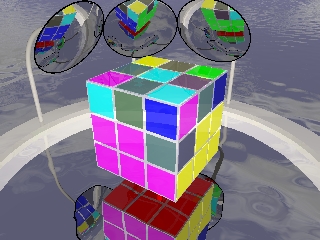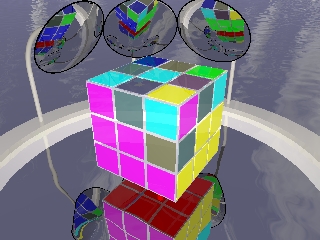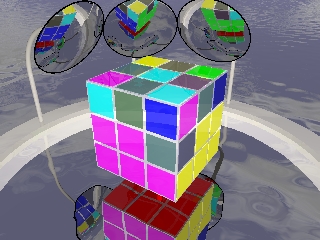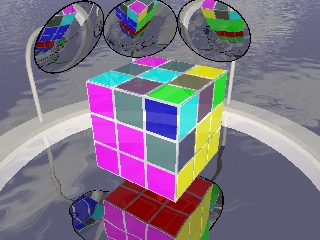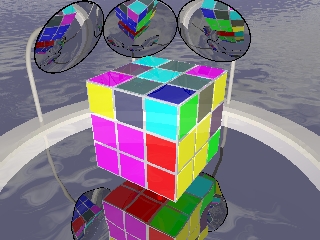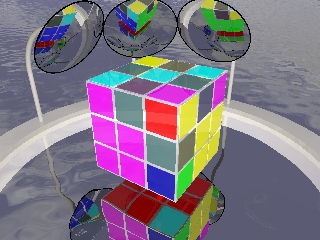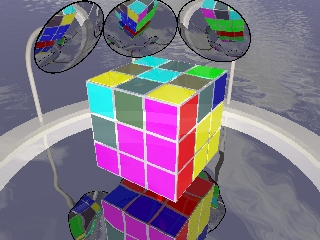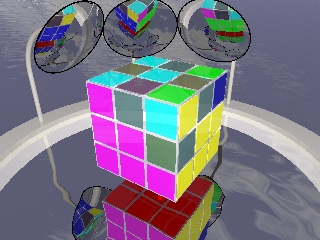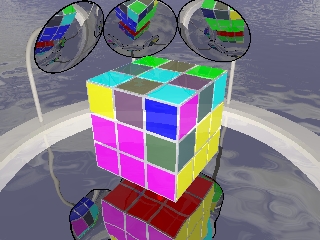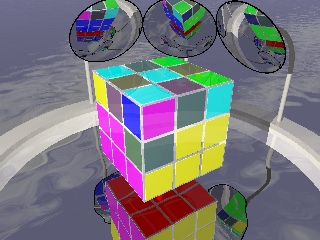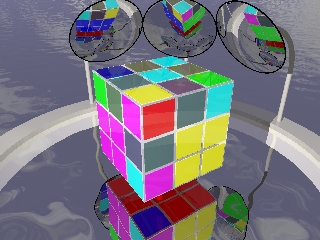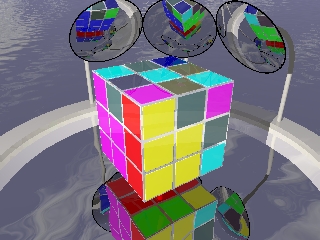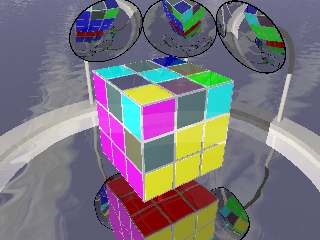This page gives you instructions for the fourth step of solving a rubik’s cube – getting the corners of the top layer into the correct places.
Note that although you get them into the right places here, they aren’t quite solved yet – they’ll still need twisting. That’s done in the next step.
The key is to use the special move – or sequence of twists – that was used to solve the edge pieces of the middle layer. The move was useful then, because it neatly dropps a single edge piece from the top to the middle layer.
It’s useful here because it also swaps two corner pieces. With a careful combination of swaps, you can get all the corner pieces into the right places, even if they are not oriented properly.
So, if you follow my strategy, your rubik’s cube will change…
|
||
|
Ok, ok, I know it doesn’t look impressive. Nobody’s going to say ‘Wow’ (nor even ‘Bow-wow’) at these before and after pics. But it is progress – if you look carefully. In the top picture, the two corners with dark blue stickers are nowhere near the blue face. In the bottom picture, these two blue-faced cubelets are much closer to home, at the back left of the cube. Similarly for all the others. Making them face the right way is done in the next step, not this one.
Solve the first two layers first!
The instructions on this page show how to get part of the top layer fixed up, and not mess up the first two layers. If you haven’t solved the first layer yet, you should start here. Or does the word layer make sense to you in this context? If you thought I meant a very thin horizontal slice of cake, please don’t hesitate to read what I do mean before moving on.
One Special Move!
Remember from solving the middle layer, a move is a special sequence of twists that helps immensely in solving the cube. Knowing good moves helps greatly in solving a rubik’s cube. When you’ve finished a move, the cube will have changed only a little bit. This means that you can focus on that little bit, and trust that the rest of the cube will be okay.
To shift around the corner pieces on the top layer, you can use the same move used for solving the middle layer. You might want to review the move again before reading on.
When solving the middle layer, I use the fact that this move does the following.
- One piece from the middle layer moves to the top,
- One piece from the top moves to the middle.
I also said Ok, ok, that’s not all. It actually makes a complete mess of the top layer. But at this stage, the top layer is already a mess, so that doesn’t matter.
Well now, it does matter. The top layer must be fixed!
The effect of the move that is useful here is that it swaps two corner pieces. So here’s the steps I use to get those ole corner pieces into line.
- Choose two corner pieces that I want to swap.
- Twist the top layer, so that the corner pieces line up with my “empty” slot in the middle layer.
- Apply the move, and then…
- Ta-daaah!! The corner pieces are swapped! Twist the top layer back so the pieces are back where you want them.
If you are careful and clever, you can always get the four corner pieces right with at most two swaps. You may have to twist the top layer a bit first though.
When they are all in the right places, it’s time to get the corner pieces to all face the right way.
Remember also that the move has a left-handed and a right-handed version. If you have a preference, you don’t need both here (although you do for the middle layer). In the pictures below, I’ll show both versions at work though.
The Right Handed Version
Here, I’ll use the right-handed version of the move to swap two corner pieces. Bring on the pretty pictures!
|
||
|
||
|
||
|
||
|
||
|
||
|
Remember, the move has a kind of rhythm to it…
- Right face up, then top face left!
- Right face back, then top face back!
- Front face over and top face back!
- Front face down and the move is done!
There’s an animated video clip showing the above (and below) steps, that you might like to check out.
The Left Handed Version
The two corner pieces at the front also need swapping. The next few pictures show how to do this, using the left-handed version of the move this time.
|
||
|
||
|
||
|
||
|
||
|
So, that’s about it! Once you’ve got all the corner pieces in the right places (it won’t take many swaps!) it’s time to learn another move, which will twist them (without a spanner) so the colours all look beautiful.
Oh, in case you need it, here’s a movie showing all the above steps!
